The approval of the Ethereum ETF may boost the yield of Ethena's synthetic dollar sUSDe, similar to the situation after the approval of the Bitcoin ETF.
Author: xpara
Translation: Deep Tide TechFlow
Key Points Summary
The SEC is expected to approve a spot Ethereum ETF, which may bring in $5 billion in the next six months.
The approval of the Ethereum ETF may boost the yield of Ethena's synthetic dollar sUSDe, similar to the situation after the approval of the Bitcoin ETF.
Ethena's products face fluctuations in funding rates, liquidity challenges, and potential risks in smart contract and custody operations, but these issues have been transparently addressed.
Ethena plans to enhance the utility of its ENA Token and is preparing to launch the Ethena application chain.
2024 is a unique year for the crypto industry. The approval of the Bitcoin ETF at the beginning of the year allowed traditional investors to gain exposure to Bitcoin price movements through regulated financial products, driving positive sentiment and market value growth.
In the crypto industry, the current trend is to launch one's own rollups and memecoins. Unlike the previous bull market cycle, this phase has not seen many new fundamental innovations. However, in the DeFi application field, Ethena stands out. Ethena's synthetic dollar USDe became the fastest to reach $30 billion in crypto dollars, surpassing the records of DAI and USDC. Its success is attributed to its non-forkable architecture, unique business model, and sustainable revenue opportunities.
Currently, the market's main focus is on the expected approval of the Ethereum ETF, expected to be announced in July this year. This may bring new liquidity to the Ethereum ecosystem, leading to other opportunities for Ethena's products—USDe, sUSDe, and ENA—to develop. This article will explore the current sentiment towards the Ethereum ETF and its impact on Ethena.
1. Current Status of the Ethereum ETF and Estimated Inflows
Until May 2024, the sentiment surrounding the Ethereum ETF was mainly one of doubt and uncertainty. This uncertainty stemmed from the historical reluctance of the U.S. SEC to approve cryptocurrency ETFs (especially Altcoin-related ETFs like Ethereum). As of July 2024, the U.S. Securities and Exchange Commission (SEC) has taken steps to approve a spot Ethereum ETF. After approving the Bitcoin spot ETF earlier in the year, the SEC in May 2024 granted a rule change allowing the listing of spot Ethereum ETFs on exchanges. Several asset management companies, including BlackRock, Bitwise, and Fidelity, have submitted applications for these products. As of July 16, the spot ETF is likely to begin trading on July 23.
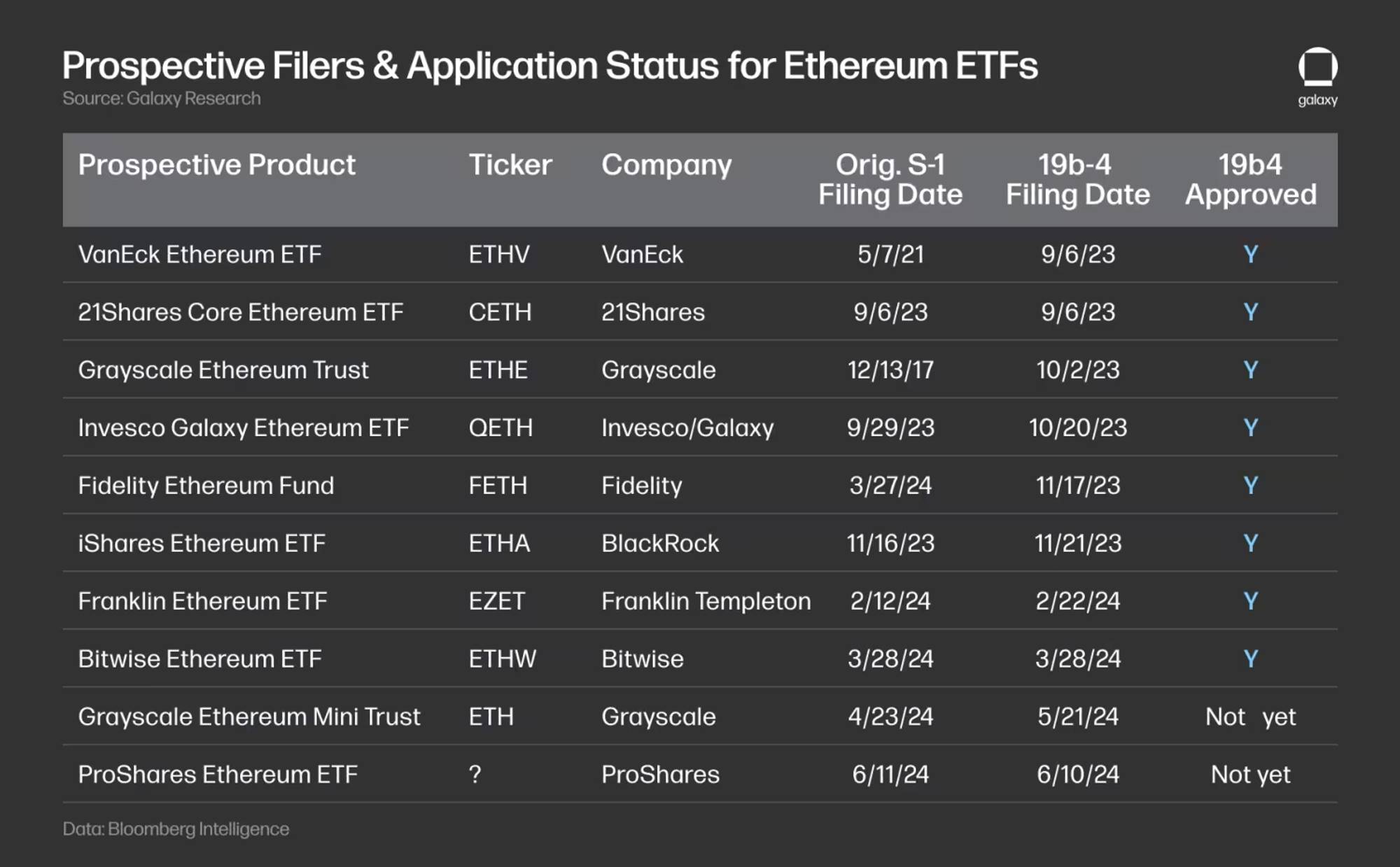
Source: Galaxy "Sizing the Market for the Ethereum ETF"
1.1 Estimated Inflows After Approval
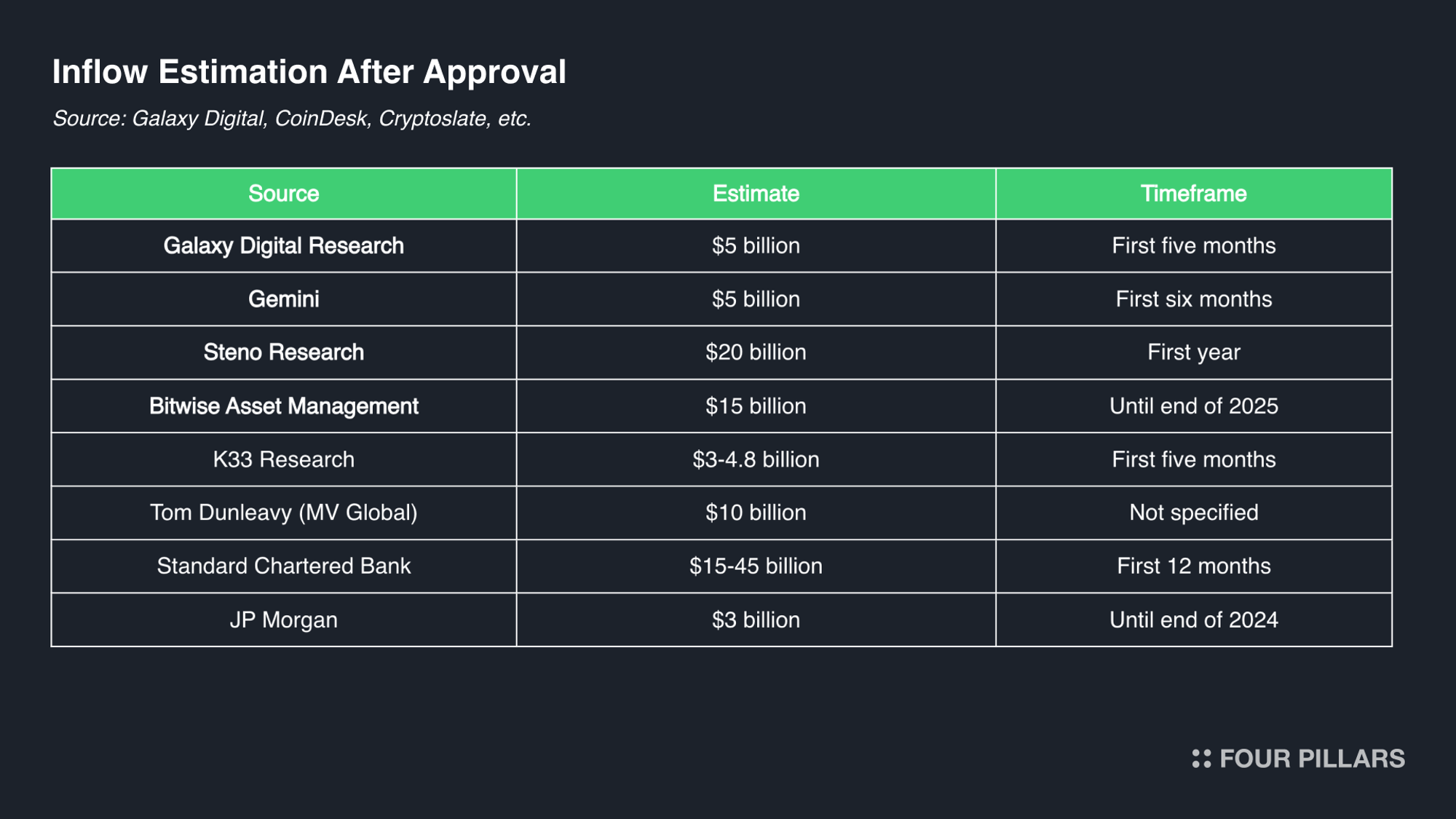
Source: Galaxy Digital, CoinDesk, Crypto Adventure, CryptoSlate, CoinDesk, Cointelegraph, The Block, Investing.com
Due to the different factors affecting the Ethereum ETF market dynamics compared to Bitcoin, such as a large amount of ETH being locked in staking, bridging, and smart contracts, it is difficult to estimate the inflow of Ethereum. With retail investors gaining easier access to this asset, this demand is expected to drive early inflows, and institutional interest will increase as wealth management platforms become more accessible. However, the lack of staking rewards may reduce some of its attractiveness.
Gemini predicts that spot Ethereum ETFs may see up to $5 billion in net inflows in the first six months of trading. On the other hand, analysts at JPMorgan are more conservative, expecting net inflows of $3 billion in 2024. Many analysts use the performance of the Bitcoin ETF as a benchmark, estimating inflows ranging from 15% to 50% of the inflows into the Bitcoin ETF. The Bitcoin ETF attracted $15.1 billion in net inflows in the first five months of trading.
There is still controversy over whether the approval of the Ethereum ETF will have a significant impact on the price of ETH similar to the Bitcoin ETF's impact on BTC. Some analysts believe that due to the current market conditions and investor saturation, the effect may be more moderate. Ilan Solot, Co-Head of Digital Assets at Marex Solutions, stated, "The pervasive bearish sentiment is a strong foundation for outperformance. Many will try to replay the BTC ETF situation for a sell-the-news strategy. However, I am concerned that many inflow predictions may be over-benchmarked, comparing to the numbers of the BTC ETF."
2. Opportunities from the Approval of the Ethereum ETF
The approval of the spot Ethereum ETF may make sUSDe an attractive choice for investors, similar to the situation after the approval of the Bitcoin ETF. Additionally, the approval may bring more institutional funds to the Ethereum ecosystem, increasing the demand for dollar-denominated yield-generating assets (such as sUSDe). As a high-yield synthetic dollar, sUSDe may attract investors who wish to maintain a dollar exposure while benefiting from Ethereum market growth.
As a complementary investment strategy to Ethereum ETF exposure, sUSDe is a good choice. Let's first review the situation when the Bitcoin ETF was approved and examine how sUSDe's yield operates and its potential influencing factors.
2.1 Review of the Approval of the Bitcoin ETF
The approval of the Bitcoin ETF had a profound impact on the market, driving up prices and funding rates. Funding rates are periodic payments between long and short positions in the futures market, which significantly increased as more traders took long positions in anticipation of price increases. These rates are influenced by the supply and demand dynamics of the underlying asset.
Before the ETF approval, funding rates were relatively stable, hovering around 10%. However, after the approval, these rates sharply increased, reaching an annualized rate of 50%. Similarly, the approval of the Ethereum ETF may drive up funding rates for ETH perpetual futures, benefiting sUSDe holders, as a portion of the token's yield comes from these funding rates.
Additionally, since the approval, the price of Bitcoin has also increased. The chart shows the correlation between the price of Bitcoin and the annualized funding rate of perpetual futures contracts from July 2023 to July 2024. The data shows that after the ETF approval, both the price of Bitcoin and funding rates significantly increased. The U.S. SEC approved the Bitcoin ETF on January 10, 2024, leading to a surge in the price of Bitcoin from around $40,000 to nearly $80,000 within a few months.
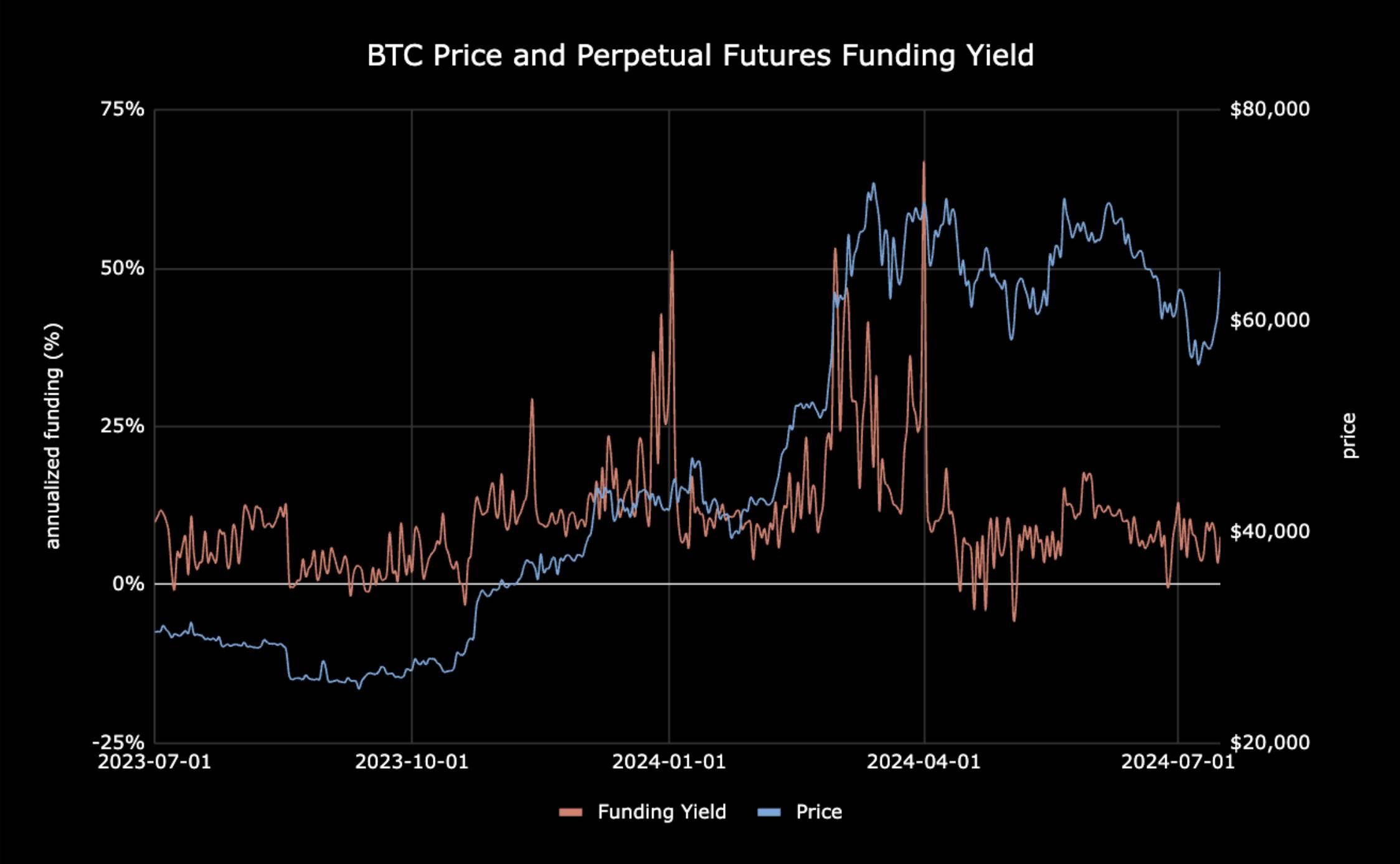
Source: Ethena
Dollar-denominated assets, such as Ethena USDe, gained significant attention after the approval of the Bitcoin ETF. These assets provided stability and attractive yields, making them ideal collateral on DeFi platforms. For example, after the ETF approval, the yield of sUSDe soared to over 30%, highlighting its attractiveness among investors seeking stable and high-yield assets. Let's take a look at how this yield operates and the potential factors that may influence it.
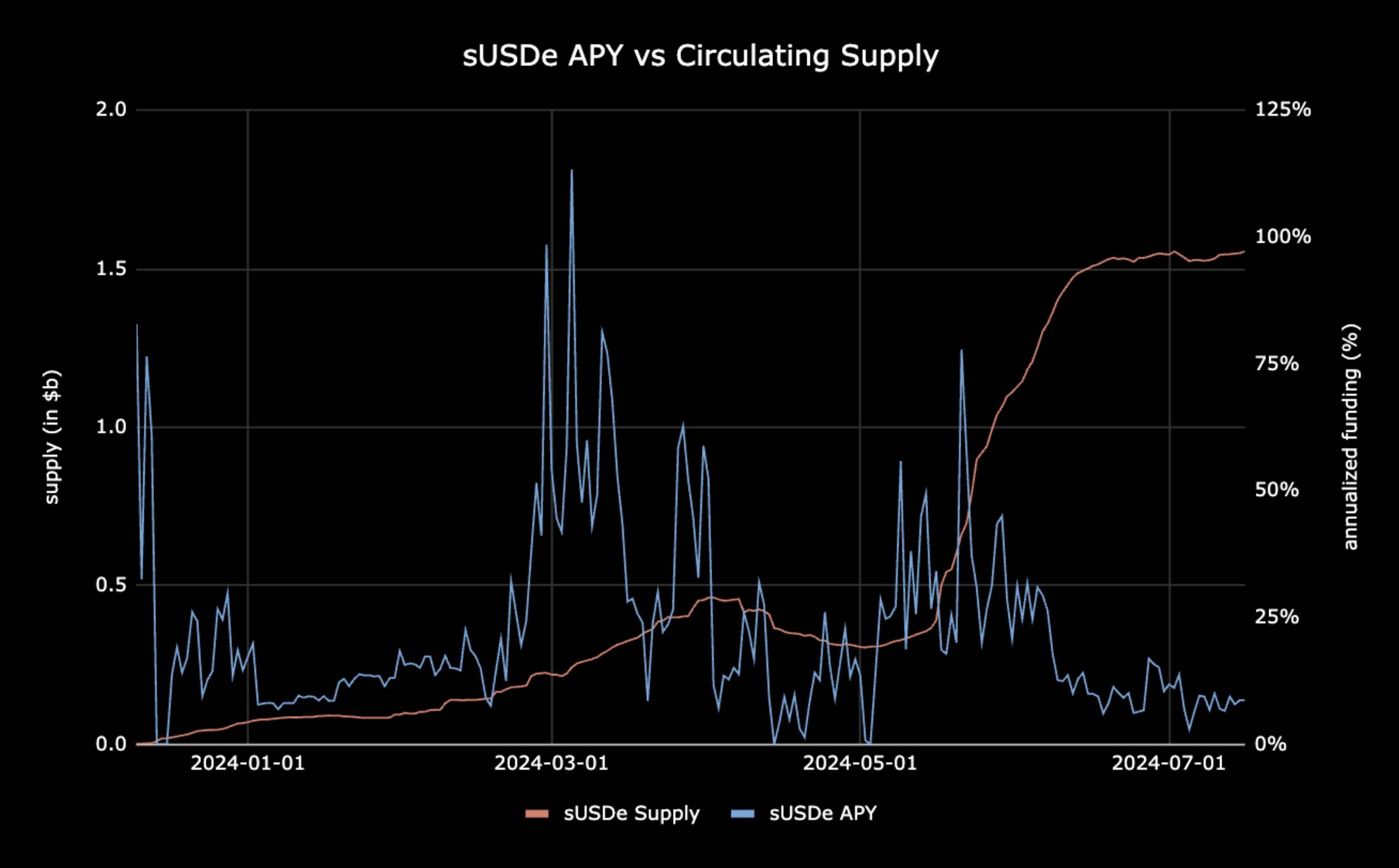
Source: Ethena
2.2 Potential Influences on sUSDe Yield
Ethena's USDe, a synthetic dollar token, became an especially attractive choice after the approval of the Bitcoin ETF. By leveraging market activity and rising funding rates, USDe was able to generate over 30% in yield after the ETF approval. This impressive return is achieved through various strategies, including Delta hedging of Ethereum collateral in the staking contract and exploiting the spread between spot and futures markets through basis arbitrage. Let's take a look at how it operates and why the approval of the Ethereum ETF may impact this yield.
2.2.1 Mechanism for Generating sUSDe Yield
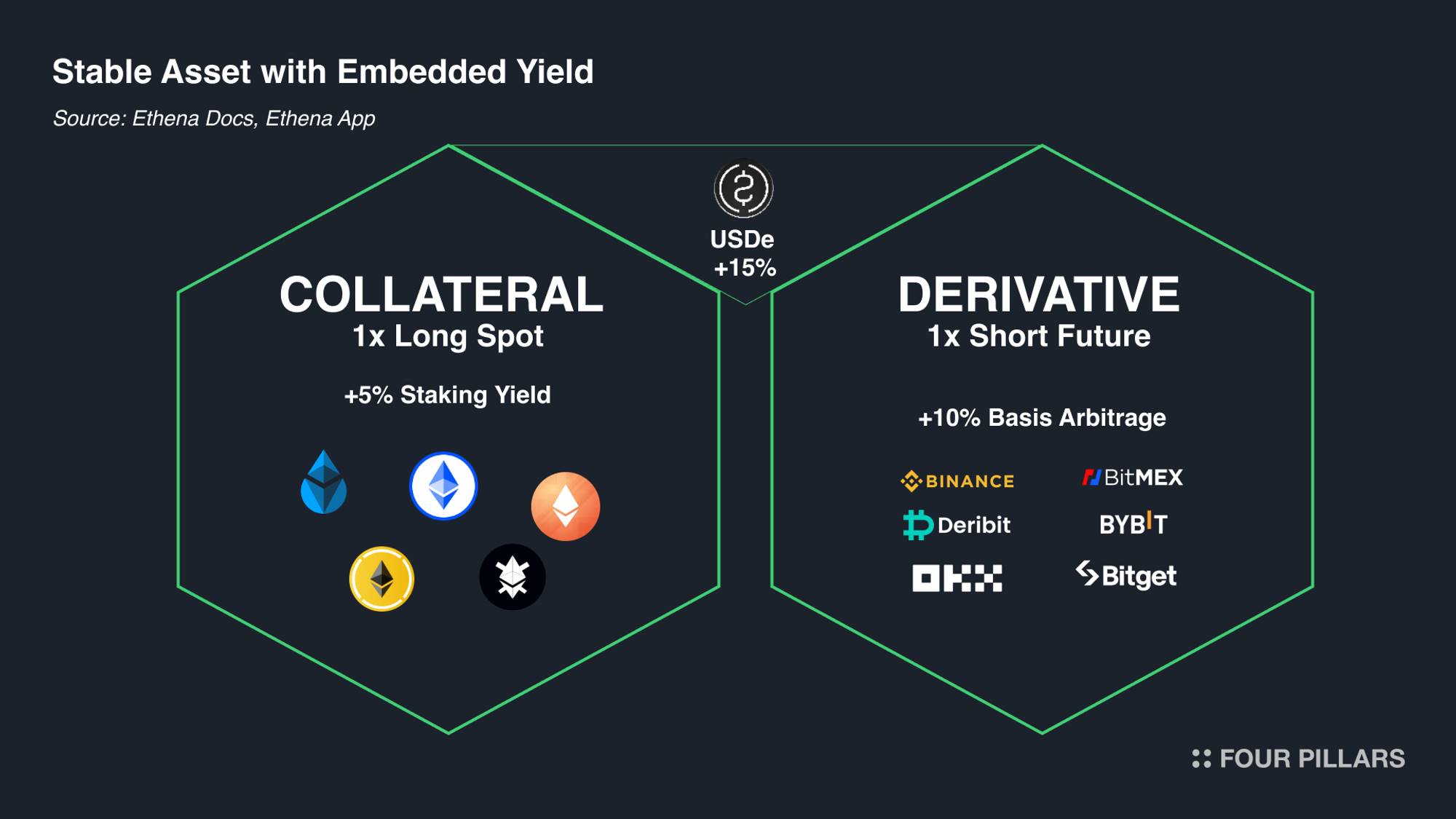
Source: Yield Explanation | Ethena Labs
In the Ethena protocol, the mechanism for generating yield for sUSDe (Staked USDe) operates through a reward-bearing "Token Vault" system similar to other staked tokens (such as Rocketpool's rETH). When users stake their USDe, they receive sUSDe tokens, representing a partial ownership of the total USDe held in the staking contract.
The protocol generates income from two main sources: staking rewards for holding assets such as stETH as collateral, and funding and basis profits earned through delta hedging derivative positions. These profits are distributed to sUSDe holders as the value of sUSDe relative to USDe increases over time. Importantly, the protocol ensures that the value of sUSDe can only increase or remain stable, with any potential losses covered by Ethena's insurance fund (however, the coverage ratio of the insurance fund is currently only about 1%). Users can benefit from the protocol's generated returns without taking any additional actions; simply holding sUSDe allows them to benefit from the protocol's generated returns. To learn more about how it operates, read the article "Ethena: Bringing Synthetic Dollars to Billions" written by Steve from Four Pillars.
2.2.2 Ethereum ETF and sUSDe Yield
One of the key factors driving higher returns for sUSDe is the continued presence of basis and funding rates in the perpetual futures market. With the approval of the Ethereum ETF, an improvement in demand for perpetual contracts is expected, as institutional investors may seek Ethereum exposure through various financial instruments. This increased demand may lead to a sustained positive funding rate environment, benefiting sUSDe holders who can earn additional income from these funding payments.
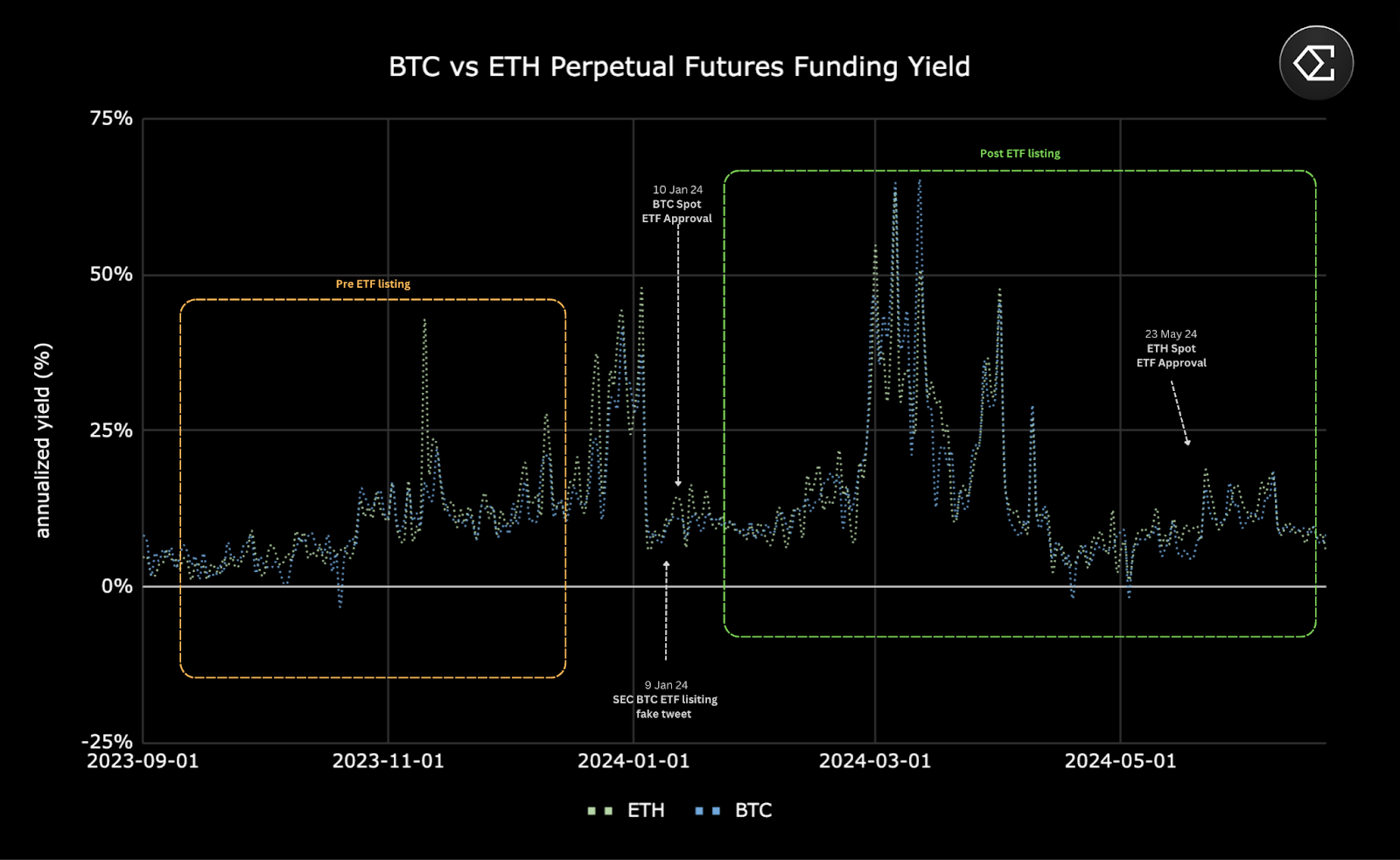
Source: Ethena
As more spot trading volume shifts to regulated ETFs, there may be a lag in spot demand from offshore exchanges, creating arbitrage opportunities. This could lead to a continued existence of the basis between spot and futures prices, which traders can exploit to bring higher returns to sUSDe holders. Additionally, the positive sentiment following the ETF approval may push up funding rates, further enhancing the yield potential of sUSDe. Historical data shows that funding rates tend to increase during periods of positive sentiment.
However, market dynamics are complex and difficult to predict, and actual results may vary due to multiple factors.
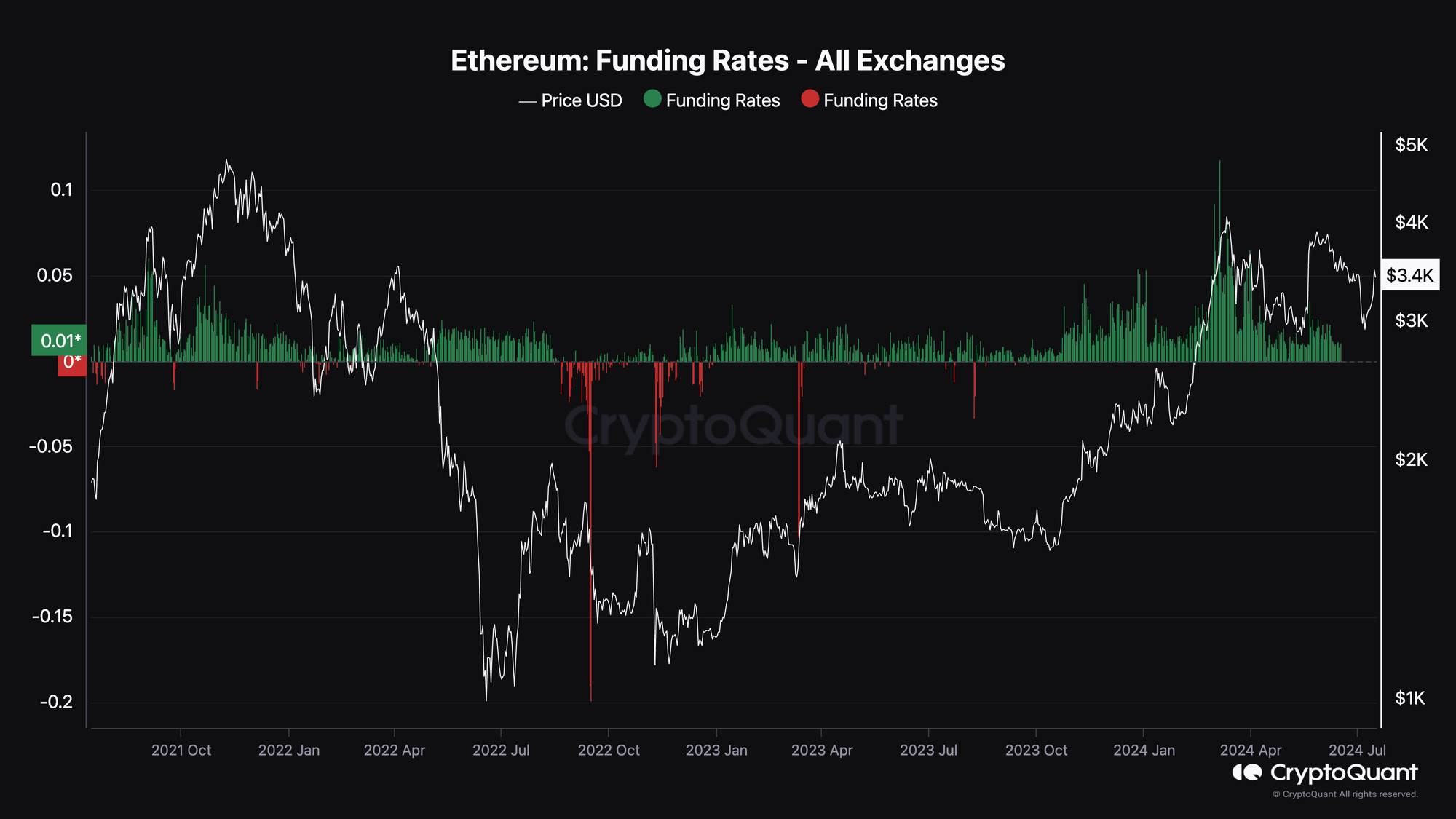
Source: Ethereum: Funding Rates - All Exchanges | CryptoQuant
3. Risks of USDe and sUSDE
Ethena has experienced rapid growth, becoming the fastest to reach $3 billion in crypto dollars. This raises the question of whether this growth is sustainable and what risks are involved. In this section, we will explore some risks.
3.1 Funding Rate and Liquidity Risk
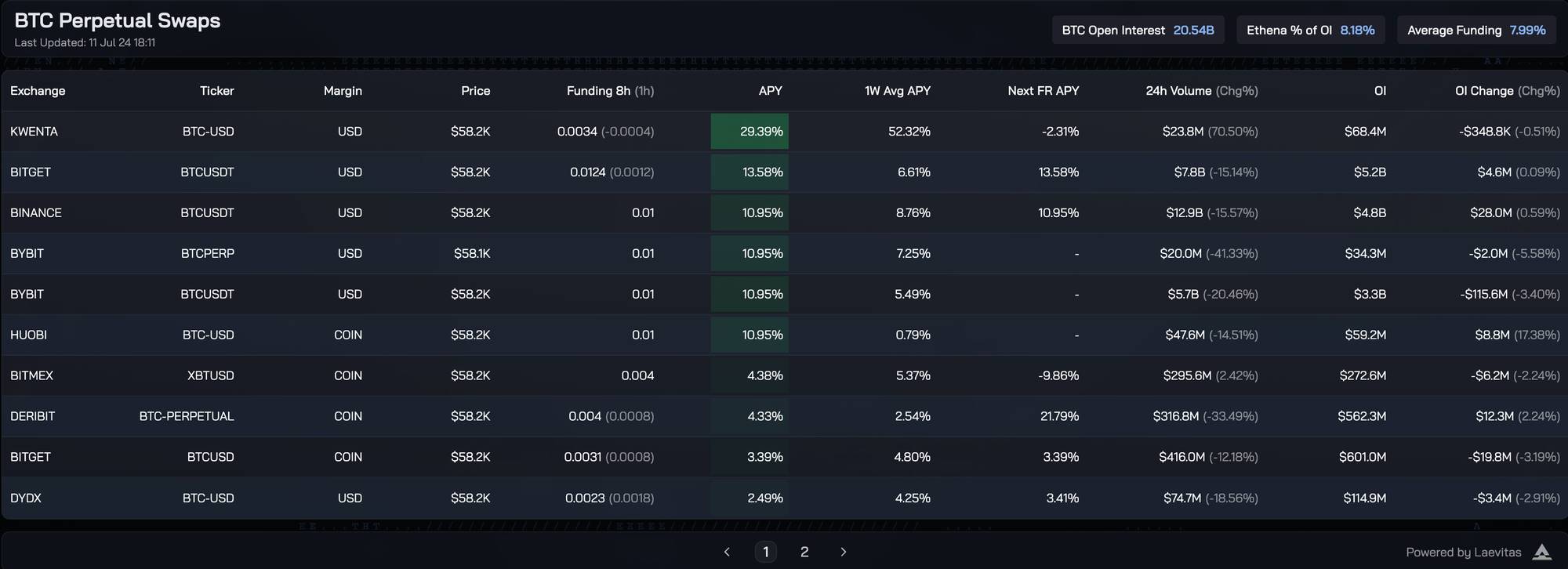
Source: App | Ethena
Ethena faces funding rate and liquidity-related risks. If there are more short positions than long positions, the funding rate may turn negative, leading to losses for the protocol. If the funding rate turns negative, the protocol will need to pay a significant amount to long positions, which could deplete the reserve fund (insurance fund). According to Ethena's research, the combined yield of stETH and short ETH funding is positive on 89% of days, but negative on 11% of days.
As the market value of USDe grows, managing becomes more challenging, and maintaining its delta-neutral position and utilizing the reserve fund becomes difficult. Additionally, liquidity risk arises if there is insufficient liquidity in the underlying derivative markets. This could affect the stability of USDe and the overall yield distributed to stakers. For example, during periods of market downturn, reduced liquidity on centralized exchanges may make it difficult for Ethena to rebalance positions.
3.2 Custody and Smart Contract Risk
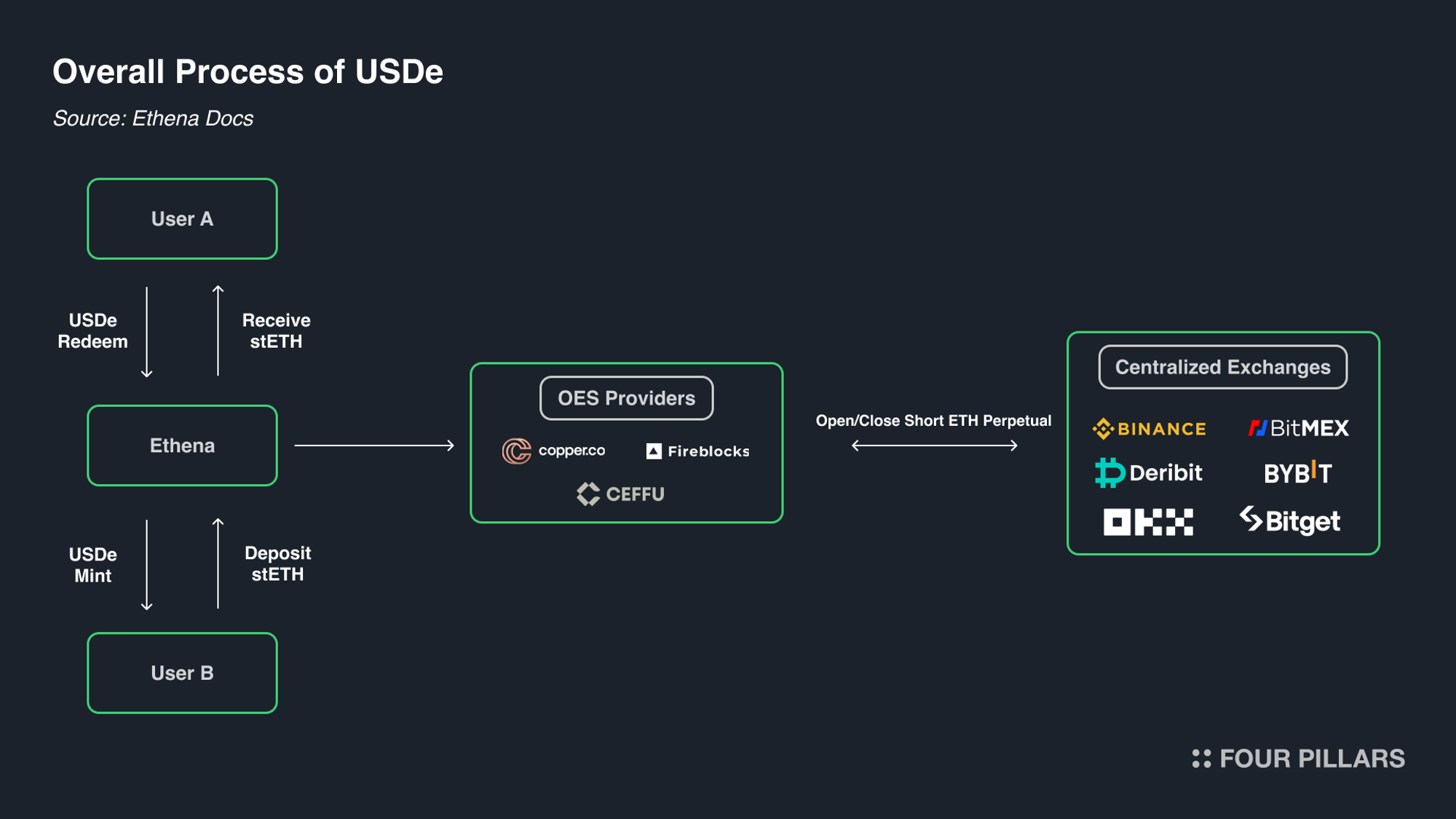
Source: Solution: The Internet Bond | Ethena Labs
Ethena also faces custody and smart contract risks. The protocol relies on external platforms such as centralized exchanges and offline settlement (OES) providers, introducing potential operational or security vulnerabilities. If these platforms face bankruptcy or operational issues, it could affect Ethena's ability to execute trades and maintain its delta-neutral position. However, if a centralized exchange goes bankrupt, Ethena's perpetual positions will be closed, but the collateral assets themselves should be safe as they never entered the exchange.
Additionally, vulnerabilities or errors in smart contracts could lead to unexpected consequences or exploitation. Although Ethena has taken measures to mitigate these risks, such as using multiple providers and active monitoring, they remain a significant area of concern.
3.3 Risks of Ethena
As Ethena's Head of Research Conor Ryder stated, Ethena has potential risks, but it is one of the few projects that openly research and establish real-time dashboards to publicly disclose the status of Ethena.
These dashboards can be accessed on the Ethena website and platforms such as Dune Analytics and DefiLlama, providing real-time information about custody wallet holdings, exchange sub-account positions, on-chain wallet assets, USDe supply, and key metrics for USDe and sUSDe. The positions dashboard displays detailed information about collateral assets, derivative positions used for delta hedging, and the circulation of USDe. (Some information may not be accessible on other platforms.)
Ethena's Head of Research Conor Ryder also stated that "explicitly, USDe is not safer or better than other projects—we just offer a risk configuration unrelated to other DeFi projects. No connection to traditional banking systems. Real yield doesn't come out of thin air. Bringing CeFi cash flows into DeFi."
4. The Situation Behind $ENA and USDe
Ethena launched its governance token ENA on April 2, 2024, marking a significant step towards decentralization and community governance for Ethena. As part of the launch, Ethena distributed 750 million ENA tokens to early ecosystem contributors and participants in its "Shard Campaign," accounting for 5% of the total supply.
To incentivize more participation in the Ethena ecosystem, Ethena previously launched the 1st season of the "Shards" Campaign in early April 2024. The 2nd season "Sats" Campaign is currently ongoing and will end on September 2, 2024. The campaign incentivizes participants to earn Sats through strategies from Pendle and Morpho, with a total token allocation commitment of 15-20% for all point activities.
The token economics of ENA are designed to balance incentivizing contributors and maintaining an active ecosystem. Core contributors hold 30% of the tokens, investors hold 25%, the Ethena Foundation holds 15%, and the remaining 30% is allocated for ecosystem development, including airdrops and funding new projects.
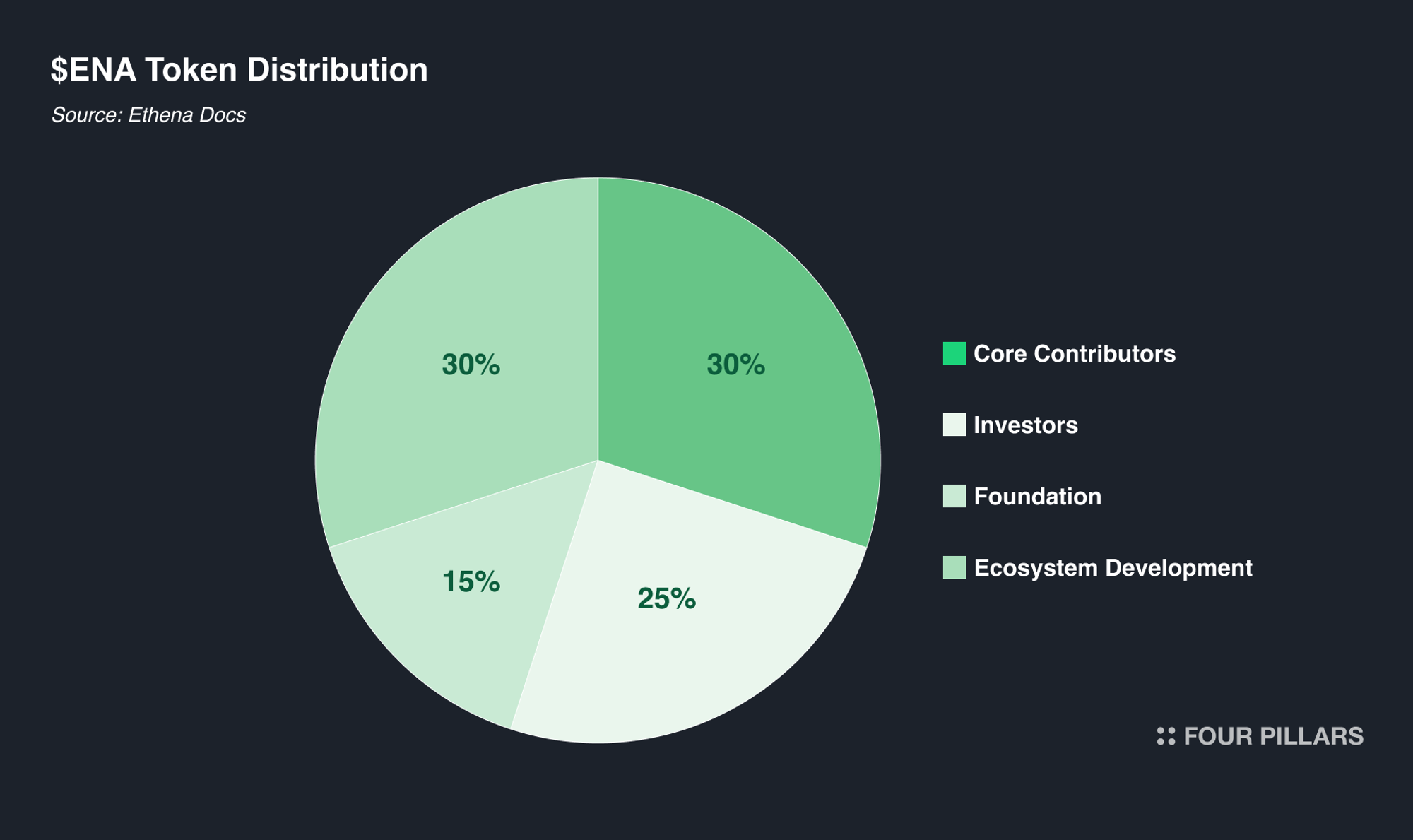
Source: ENA Token Launch — Ethena Labs
Like many utility tokens, $ENA serves as the governance token for the Ethena protocol, allowing holders to make decisions on various matters, including determining collateral assets for USDe (modification or addition), selecting custodial entities (OES providers), cross-chain implementations, grants, which exchanges to use, and choosing risk management frameworks.
However, the current utility of the ENA token is limited. Despite Ethena's rapid growth in TVL and being one of the top projects generating significant revenue, this revenue is not currently shared with token holders.
This situation is expected to change in Ethena's future development. Ethena will not be just another DeFi project. It has a roadmap that will make $ENA more meaningful, with two potential opportunities being potential revenue sharing and the Ethena Appchain.
4.1 Potential Revenue Sharing
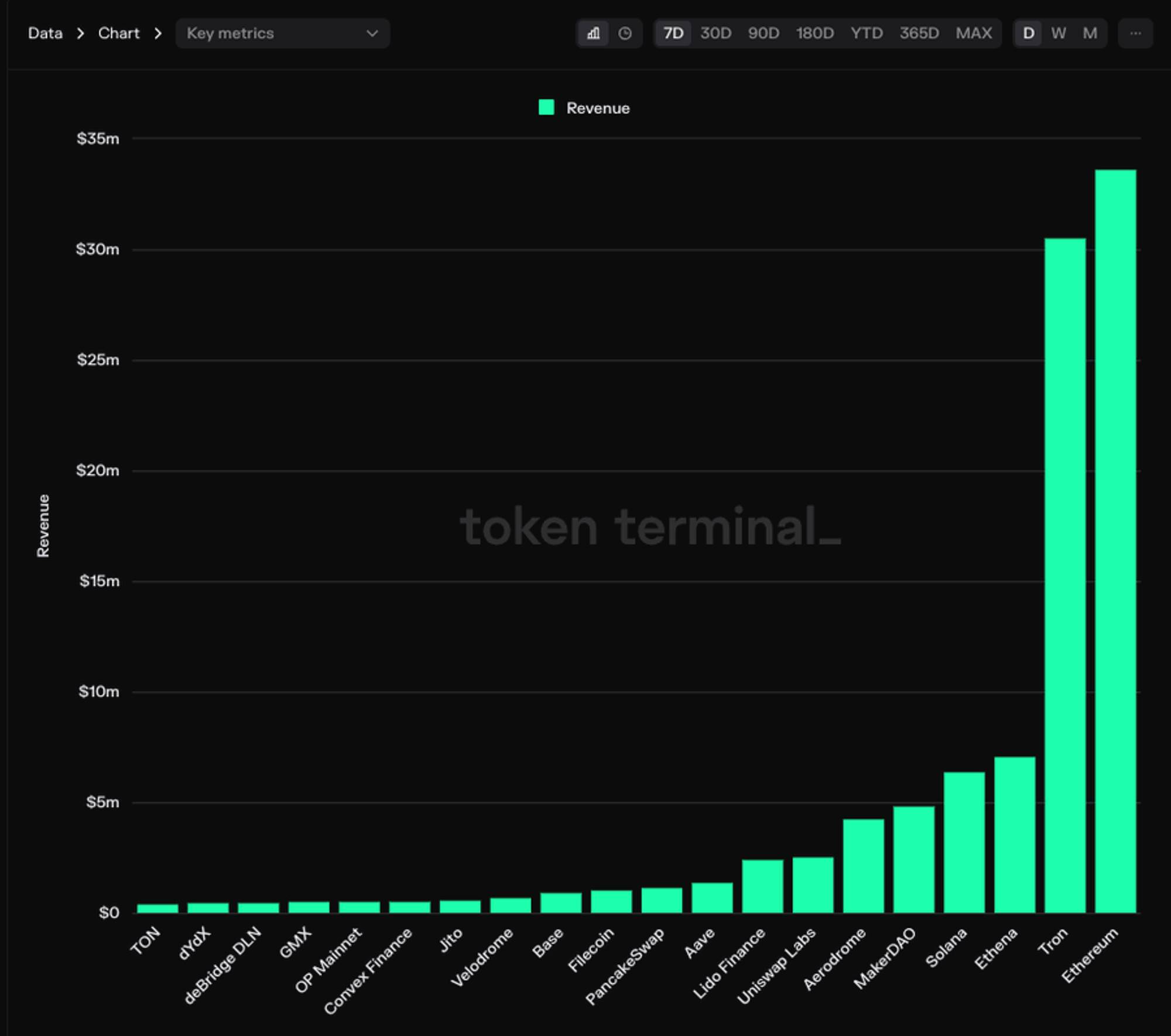
Source: Token Terminal [Date: Monday, May 27, 2024]
Ethena has experienced significant revenue growth, with its synthetic dollar USDe becoming the fourth-largest stablecoin by market capitalization. Here are some key points about Ethena's revenue growth:
Revenue Leader: In the last week of May, Ethena's USDe generated $7 million in revenue, surpassing Solana's $6.3 million. Only DApp revenues from Tron and Ethereum exceeded it.
Market Cap: The market cap of USDe has exceeded $3 billion, making it the fastest-growing crypto dollar asset in history.
Revenue Forecast: According to Token Terminal data, Ethena is expected to generate $222.5 million in revenue over the next 12 months.
As the governance token of the Ethena protocol, ENA token holders may have the opportunity to vote on proposals, including revenue distribution mechanisms. This may allow ENA holders to influence decisions on the allocation of protocol revenue, which may include returning a portion of the earnings generated from USDe collateral or other protocol activities to token holders.
4.2 ENA Appchain and Re-Staking
Recently, Ethena updated the roadmap for the ENA Token and introduced new token economic initiatives. Ethena launched staking for ENA, providing security for cross-chain transfers and integrating ENA into its financial infrastructure, including the upcoming Ethena Appchain. Additionally, users are required to lock up at least 50% of claimable tokens to incentivize long-term holding for ENA holders. This measure is part of the strategy to ensure ecosystem stability and growth.
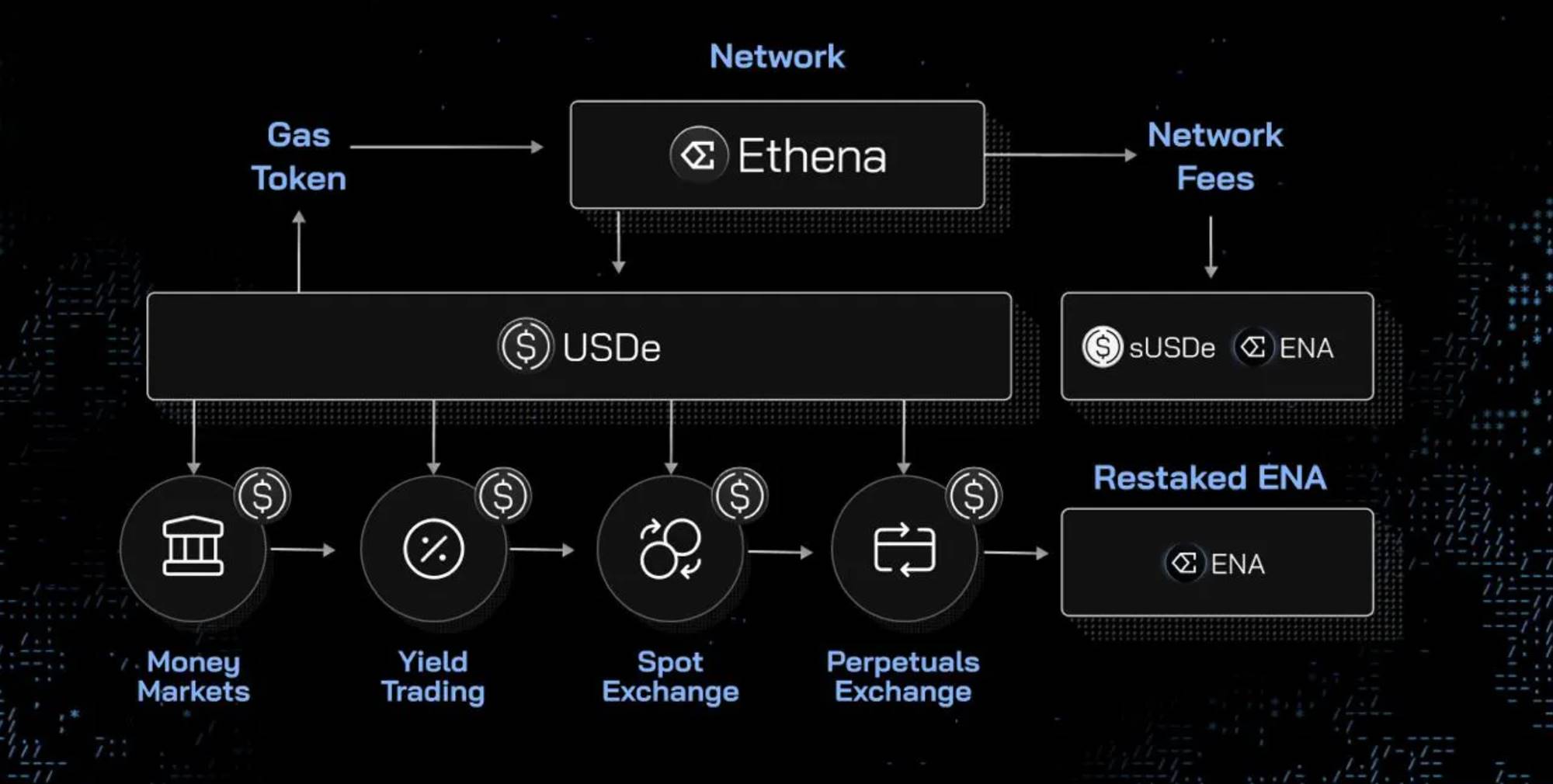
Source: Update to $ENA Tokenomics — Ethena Labs
The protocol introduced general re-staking for ENA, and ENA re-staking pools within Symbiotic may receive rewards. These pools will provide economic security for cross-chain transfers of USDe, utilizing the LayerZero DVN messaging system. This initiative is part of the development of the Ethena Appchain, aimed at building financial applications and infrastructure using USDe as the primary asset. ENA staked in these pools will receive various rewards, including high multipliers, Symbiotic points, and potential future allocations from LayerZero.
Looking ahead, the utility of ENA will significantly expand. Ethena's roadmap plans to integrate ENA into various financial applications and infrastructure solutions on the Ethena Appchain, including spot DEX, perpetual decentralized exchanges, yield trading platforms, money markets, and uncollateralized lending protocols. Additionally, ENA can also be used for on-chain prime brokerage services, options, and structured products. These wide-ranging applications will not only enhance the utility of ENA but also drive its demand as the ecosystem grows.
5. Future Outlook
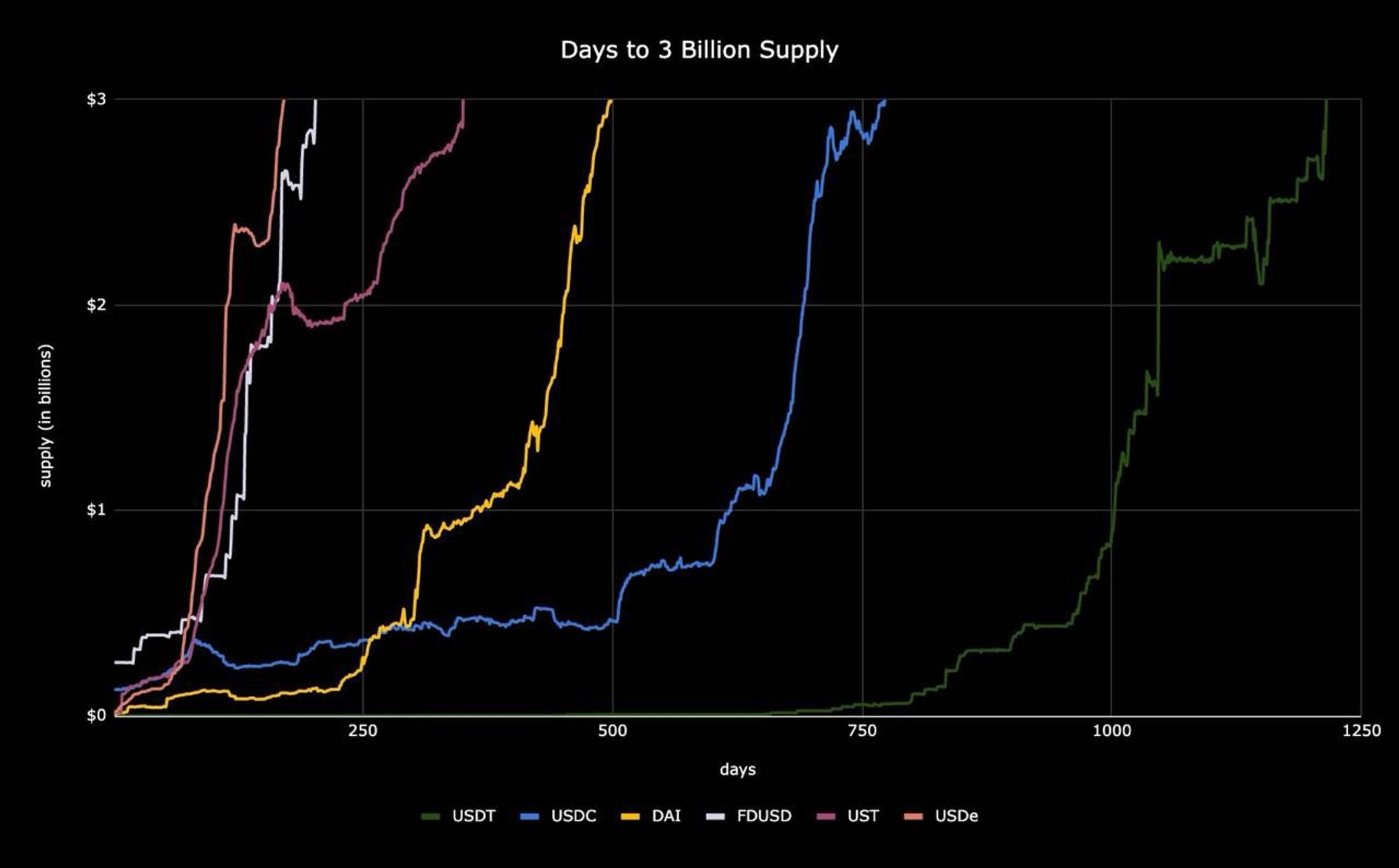
Source: X (@leptokurtic_)
The approval of the Ethereum ETF marks a crucial moment for the cryptocurrency market, similar to the impact of the Bitcoin ETF earlier this year. This development is expected to bring significant liquidity and institutional interest to Ethereum, potentially impacting its price and the market. Ethena, with its synthetic dollar USDe and revenue token sUSDe, is in a favorable position to benefit from these changes. The increased demand for ETH-related financial instruments may drive positive funding rates and create arbitrage opportunities, leading to higher returns for sUSDe holders. A similar situation occurred after the approval of the Bitcoin ETF.
However, it is important to recognize the inherent risks associated with rapid growth and market changes. Ethena must address challenges related to funding rate fluctuations, liquidity management, and custody and smart contract vulnerabilities. Despite these risks, the platform's transparent risk management approach and proactive measures, such as real-time dashboards and the use of diverse providers, increase confidence in it.
Since its inception, USDe has achieved exponential growth, making it the fastest crypto dollar to reach a $30 billion market cap. With the approval of the Ethereum ETF, further growth is expected for Ethena. Additionally, expanding the utility of ENA through initiatives like revenue sharing and the Ethena Appchain may provide additional value and stability. Therefore, paying attention to this opportunity is crucial.
Appendix A: Key Milestones of the Ethereum ETF
A.1 January 2024: Bitcoin ETF Paves the Way
In January 2024, the approval of the spot Bitcoin ETF marked a significant milestone and paved the way for altcoin ETFs, with Ethereum being the next potential candidate. The success of the Bitcoin ETF brought unprecedented net inflows, solidifying BTC's status as a legitimate investment asset. The launch of these Bitcoin-tracking funds became one of the largest debuts in ETF history. According to Morningstar Direct data, this translated to $8 billion in net inflows. By the end of June, the nine newly launched products had accumulated $38 billion in assets, demonstrating strong investor demand for gaining exposure to cryptocurrencies through traditional financial instruments.
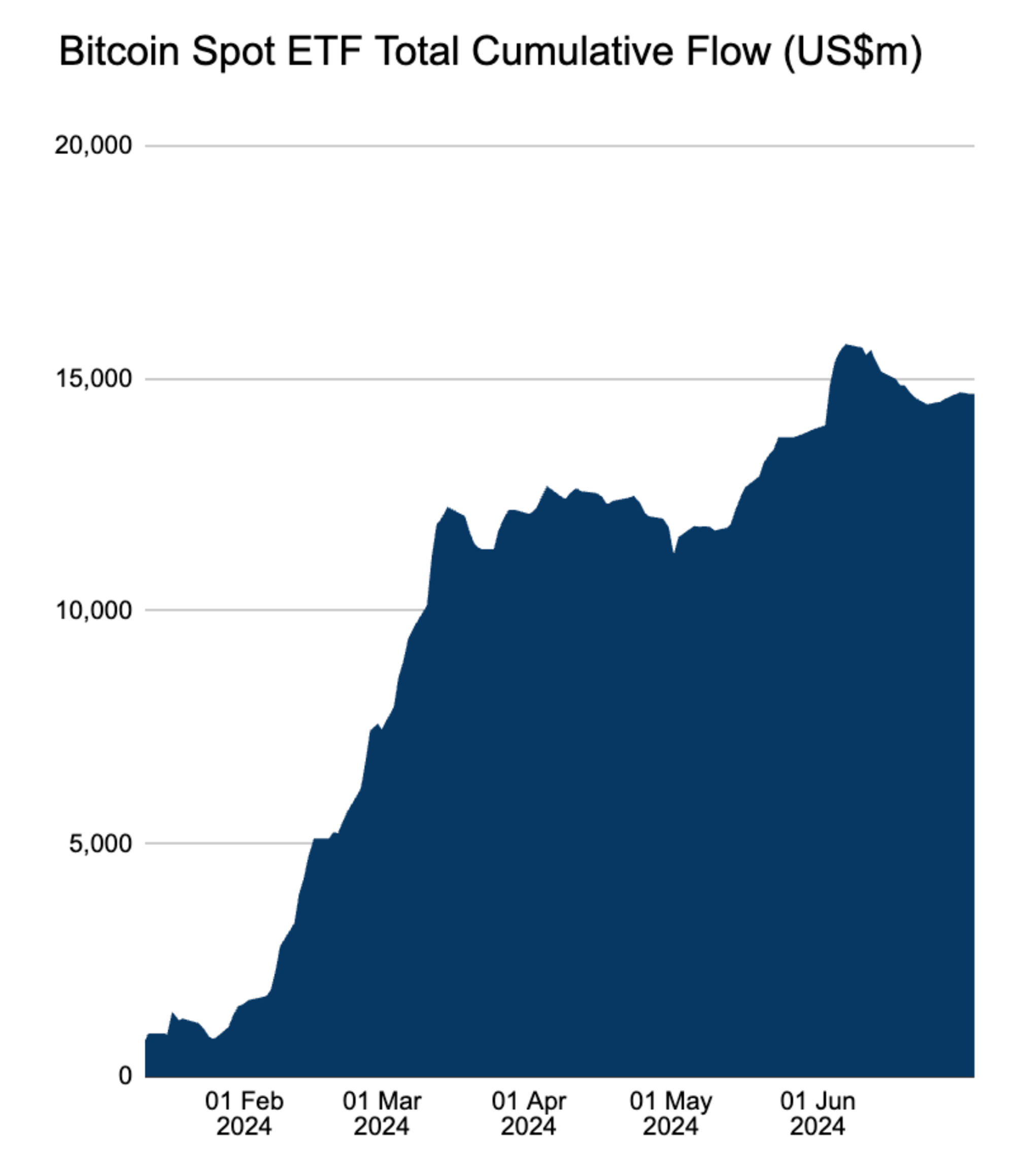
Source: Bitcoin ETF Flow – Farside Investors
A.2 May 2024: Momentum for Ethereum ETF
In May 2024, the U.S. Securities and Exchange Commission (SEC) approved a rule change to allow the listing of spot Ethereum ETFs on major exchanges, making an important regulatory change. This decision allows Nasdaq, the New York Stock Exchange, and the Cboe Exchange to list eight Ethereum ETFs. The SEC's approval came after the applicants modified their filings to align with regulatory preferences, particularly by removing Ethereum staking from ETF fund operations, which was seen as a potential obstacle to approval.
The rule change required ETF issuers to update their 19b-4 forms, which are used to propose new rules or changes to existing rules for self-regulatory organizations (such as stock exchanges). While the SEC approved the forms for these eight spot Ethereum ETFs, including ETFs from Bitwise, BlackRock, and VanEck, the issuers still need approval for their individual S-1 registration statements to officially begin trading.
A.3 June 2024: Expectations and Delays
In June 2024, expectations for the approval of the Ethereum ETF continued to grow. SEC Chairman Gary Gensler indicated that the approval process was progressing smoothly, and some analysts predicted that it could potentially launch as early as July 4th. However, the SEC delayed the launch of the spot Ethereum ETF, pushing the timeline to mid-July or later.
A.4 July 2024: Delays and Uncertainty
By July 2024, the delay in the approval of the Ethereum ETF led to uncertainty among investors. Despite some analysts predicting a launch within the next two weeks, the market remained cautious. Bitwise submitted a revised S-1 form, indicating that these products were nearly ready to launch, but the SEC's comments further postponed the timeline. Market sentiment was mixed, with some analysts predicting that if the ETF failed to generate significant inflows, the price of ETH could decline.
A.5 Mid-July 2024: Confirmation Imminent
There are reports suggesting that the spot Ethereum ETF could potentially start trading as early as next week. According to sources familiar with the matter, the U.S. SEC has informed the issuers of Ethereum exchange-traded funds that their funds can begin trading on July 23, 2024. It was reported that the SEC did not provide further comments on the recently submitted S-1 forms and requested the final version to be submitted by Wednesday, July 17. Market reactions reflected optimism about the potential impact of these new financial products on the broader cryptocurrency ecosystem.
免责声明:本文章仅代表作者个人观点,不代表本平台的立场和观点。本文章仅供信息分享,不构成对任何人的任何投资建议。用户与作者之间的任何争议,与本平台无关。如网页中刊载的文章或图片涉及侵权,请提供相关的权利证明和身份证明发送邮件到support@aicoin.com,本平台相关工作人员将会进行核查。




